Definition
Natural selection is a pressure that causes groups of organisms to change over time. Animals inherit their genetics from their parents or ancestors, and the environment is constantly changing. So, no organism is perfectly adapted to its environment. Thus, natural selection is constantly influencing the evolution of species.
Natural Selection Explained
Even if a parent were perfectly adapted to the environment, the environment will change, leaving the offspring maladapted to the environment. Because there are many animals and few resources, only the best and most fit organisms can reproduce. Natural selection works against all organisms, and it can be thought of as the environment and forces acting to stop organisms from surviving and reproducing. Therefore, organisms which are able to survive can also pass on their DNA to the next generation. This “selects” for those DNA sequences.
Luckily for all organisms, genetic variability causes each individual to be slightly different. These slight differences in performance can lead to differences in the amount each individual reproduces. By reproducing more, an individual creates more of the genetic variations that helped it succeed. The offspring of these individuals will also benefit from the genetic variations that allowed their parents to succeed. Organisms without these genetic adaptations will not reproduce as much, and in this way, their lines will someday cease to exist. Nature constantly exerts a selective force on the different genetic combinations that try to reproduce, and in this way, natural selection is the major driving force of evolution.
Natural Selection Examples
Example of Stabilizing Selection
For stabilizing selection, imagine a population of mice that lives in the woods. Some of the mice are black, some are white, and some are grey. If the mice had no predators, and no other forces acting on the color of their coat, it would have no reason to change and would only change randomly in response to certain mutations in the DNA. However, that is not the case with these mice. They have lots of predators.
Foxes and house cats prey on the mice during the day. In the nighttime, the owls and other predators scour the dark for dinner. Either way, the mice are in a tough position. But not all the mice face the same risk at all times. In the daytime, the black mice are much easier to spot, and predators eat more black mice. The white mice stand out at night. This means owls eat more white mice at night. The grey mice are the only ones who survive more both during the day and at night. By the next generation, there will be many less black and white mice to reproduce.
After a few generations of strong selective pressure, the entire population could be grey. It depends entirely on the genetic makeup of the trait, but in some cases, a single trait is selected for and the rest are lost from the population. In other cases, the black and white coat colors could just become rarely seen traits. Retaining the traits can be an advantage when the predators change. For instance, if all the owls and night predators disappeared, it would be more beneficial to be black. The black mice would then take off, and become more frequent in the population.
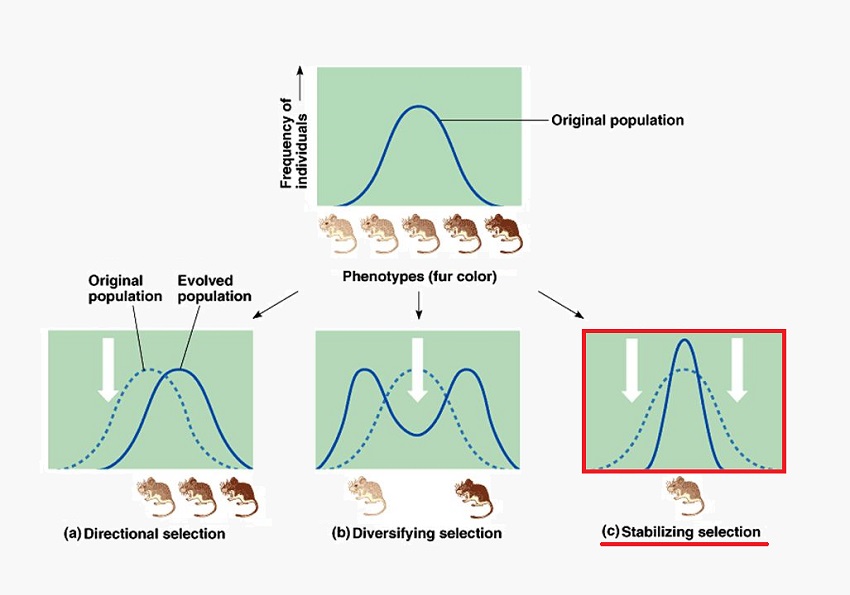
Example of Directional Selection
It is important to consider different traits in the same population of animals. Imagine again the population of mice living in the woods. Instead of their color, consider a trait that runs on a continuous scale. Imagine that the mice vary in size from a normal sized mouse to something much larger than a rat. Although the mice are the same species, they grow into many different sizes. The predators, however, have a terrible time trying to catch and eat the largest of the mice. Not only do the large mice weigh more, but they can fight back. The smaller mice are mostly defenseless and provide the perfect sized snack.
If this were the case, and nothing was holding them back, the mice would get much larger. This is directional selection. This is probably what happened in the case of the capybara, a giant South-American rodent. Like our fictional rodents, the pressures of their environment have caused them to be much larger than any other rodent known to man. Many rodents find different advantages in being small, which is why most rodents have remained a certain size. These advantages could be as simple as the ability to hide or the availability of food, but animals of certain sizes do better for different reasons, and populations can change size over time.
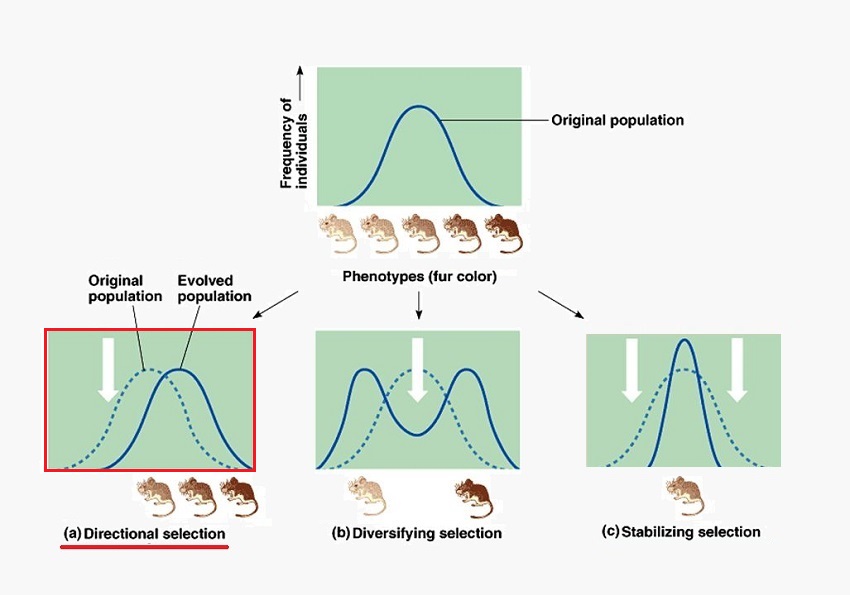
Example of Diversifying Selection
Okay, last time with the mice. But this time, consider a new trait in the population. Let’s imagine that some of the mice begin to grow skin flaps between their front and back legs. Effectively, it makes a parachute that allows them to glide away from predators. Mice that fully have the skin flaps do really well and are almost always able to escape predators. Likewise, mice without the flaps avoid the trees and open spaces that mice with flaps venture into, and are much better at hiding from predators. The largest selective force is against the mice in the middle.
Without the ability to glide away, mice somewhere in the middle cannot escape predators at a rate that can help them reap the benefits of the trees. At the same time, the half-flaps make it harder for them to run and hide from predators. Because of this weakness, many more of these mice from the middle of the spectrum are eaten. This begins to divide the population into two distinct traits. Eventually, this can lead to the mice becoming an entirely different species.
It is possible that this is how bats became the only flying rodents. Much like the imaginary scenario described, there are real rodents that do not fly, some that can glide, and bats. While the common ancestor between all of these animals might not have been called a rodent, they are all mammals. Much like our imaginary scenario, diversifying selection could have caused the population of the common ancestor to change and separate. In the real world, selective pressures are much more complex, and we can only guess at the exact historical relationship between animals.
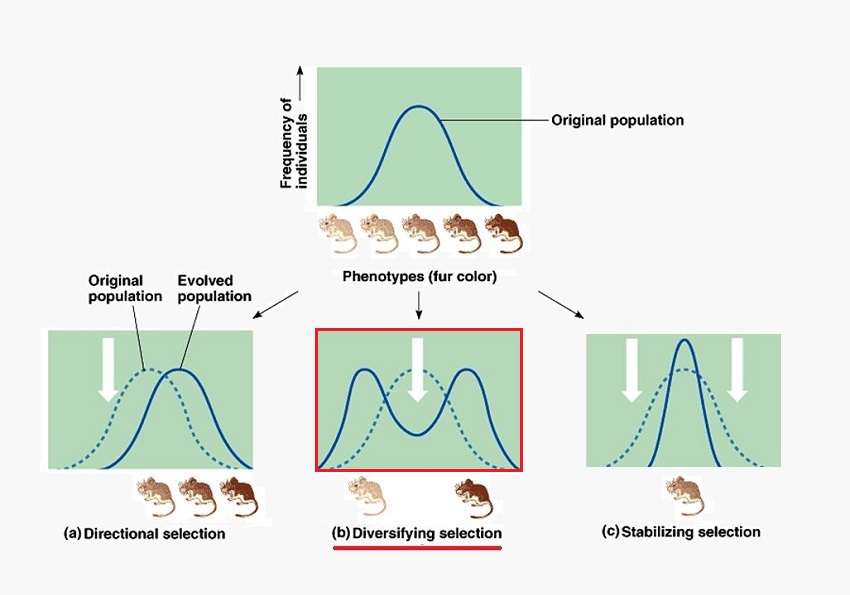
Example of Sexual Selection
Look at a peacock. Try to imagine a functional use of that ridiculous tail. Stumped? Scientists were, too, until the mechanism of sexual selection was explained. This form of natural selection can sometimes select for functional adaptations, but often produces bizarre adaptations that only serve in attracting mates. In the case of the peacock, the colorful tail is used in a display meant to attract females. Males with larger tails and more dazzling colors are preferred to males with small tails. This peculiar preference seems to have no actual bearing on how successful the males could be in collecting food and reproducing, but because of the preference of the females, all male peacocks have large, colorful tails.
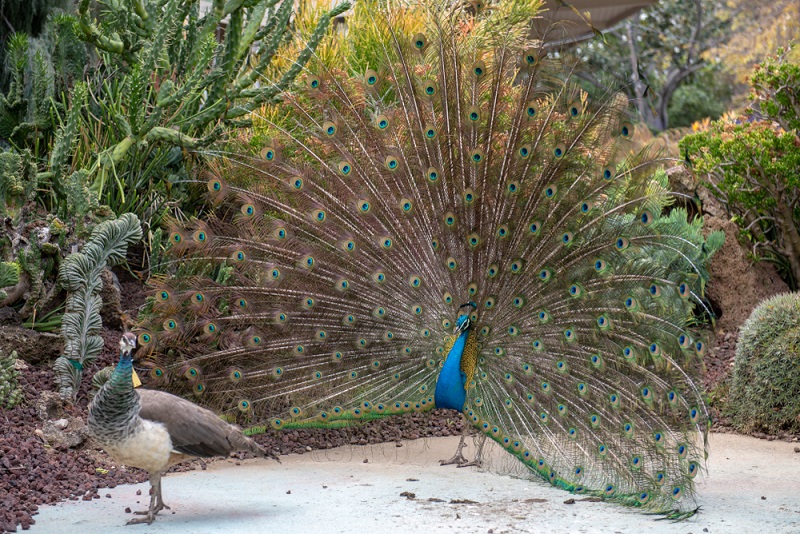
Interestingly, this pattern of males becoming the more decorated of the genders holds true for many bird species. Male ducks, many male tropical birds, and even the male common house sparrow are all much more decorated than their female counterparts. This is also seen in some reptiles. In fact, many animals have adapted strange displays or methods of decorating their nest to attract mates. The selection can work in both ways and depends mostly on which sex can be choosier in selecting a mate.
Example of Predator-Prey Selection
The fastest land predator is the cheetah. Cheetahs did not get extremely fast for no reason. The cheetah’s main prey item, the antelope, is fast as well. Which one got fast first will forever remain a mystery, but the fact is, these two species drive each other to be faster.
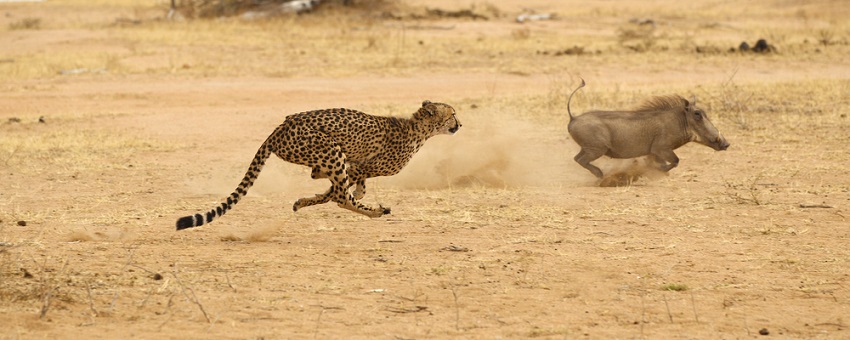
Faster cheetahs experience an advantage over other cheetahs in that they catch more antelope, and can support a much larger family. Eventually, slow cheetahs will die off, and the fast cheetah population will explode catching antelope. The antelope population, responding to the new selection, are also more successful when they are fast enough to avoid the cheetahs. Thus the antelope population is also being directionally selected for faster animals.
Scientists theorize that this give-and-take between the predator and prey populations is responsible for shaping many of their defining traits. In fact, scientists were baffled why the American Pronghorn, a species that resembles antelope in size and speed, would exist considering the lack of cheetahs in North America. Without a predator fast enough to catch you, at a certain point the extra speed is of no great advantage. Scientists remained baffled until the fossils of a cheetah-like predator were found in North America. Unlike the cheetahs of Africa, the cheetahs of North America did not survive human expansion, and the pronghorn is left without a predator.
Principles of Natural Selection
There is an incredible variety of selective forces in the natural world, ranging from interspecies competition, to predator-prey dynamics, to sexual selection between the different genders. The defining characteristic of natural selection is that it is a force that allows some organisms to reproduce more than others. Natural selection does not always lead to the “right” answer, as some people tend to think.
Natural selection is an imperfect process. It cannot create new DNA spontaneously, or change the DNA it is given in meaningful ways. It can only slow or stop the reproduction of some DNA while allowing other DNA to persist. Every population has the opportunity to adapt, migrate to different conditions, or go extinct in the face of natural selection.
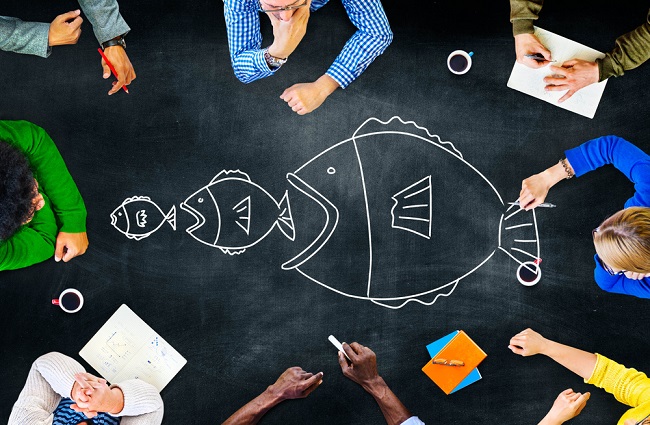
The process of natural selection screens the DNA it is given, with the minor mutations and recombination that occurs during replication, and simply does not let some DNA pass. Sometimes, the screen is random, as in a lighting strike killing a single tree. Other times, the screen is biased towards certain types of organisms, causing a selection to happen. This can be seen in the pine beetle invasion in North America. The pine beetles are being selected for because they are exploiting a rich food source. The pine trees, on the other hand, are being selected against for not having adequate defenses against the beetles.
Types of Natural Selection
As animals diversify and fill different niches, the pressures exerted on them can change in many ways. The functional requirements to be a bird are much different than those required to be a fish. Their food is different, the medium they exist in is different, and they must obtain oxygen in a different way. Natural selection thus selects for very different looking animals to fill the different niches of the ecosystem.
Regardless of the trait, natural selection tends to do one of three things to a population. It can keep the trait the same, stabilizing selection, move the trait in one direction, directional selection, or select for the extreme values of the trait, diversifying selection. In addition to being classified by the effects it causes, natural selection can also be classified by the relationships of the organisms causing the natural selection, and sometimes the selection can be made by abiotic factors.
Type 1: Stabilizing Selection
Most traits in the animal kingdom can be described by a bell curve, in terms of their distribution. Most animals of a certain species tend to show the same trait or feature, of relatively the same size. There are always some exceptions of larger or smaller traits in certain individuals, but generally, most individuals sit somewhere in the middle.
Stabilizing selection is a form of natural selection that screens against the outliers, or exceptions to the trait. The screen prevents those animals from reproducing as much as the “normal” or more regular individuals. More babies are born that are “normal” and fewer outliers are seen in each consecutive generation because of this bias. It is in this way that species can become very distinct from other species, yet all members of a species will look exactly alike.
Type 2: Directional Selection
Directional selection is a type of natural selection that occurs when one side of the spectrum of a certain trait is favored over the other. For instance, if the smallest organisms get eaten, and larger organisms are totally protected, the population will tend to get much larger. If the opposite is true, the population will decrease in size over time.
It is also using directional selection artificially that humans can create “miniature” breeds of animals, which look like tiny copies of their larger counterparts. However, artificial selection only focuses on a single trait. This allows many negative traits to become present in the population, which would have naturally been selected against.
Type 3: Diversifying Selection
Much like directional selection, diversifying selection pushes the population towards the extremes of the trait. This type of selection is also called disruptive selection. Diversifying selection, in contrast to directional selection, pushes the trait both ways. This can happen in a variety of ways, but it often leads to speciation because the populations can become so different. If only diversified for short times, however, the selection can lead to a variety of traits that can be shared by one species.
Type 4: Sexual Selection
While you can classify natural selection in terms of the effects it has on the population, you can also view it as the interaction between organisms with different relationships. Sexual selection is a kind of natural selection in which the different genders in a species exert forces on each other that changes their appearance or traits. To humans, these traits often appear arbitrary, such as brightly colored feathers, the ability to do a ritualized dance, or certain nesting traits such as decorating, that don’t appear to serve a function in reproduction.
In many organisms, sexual reproduction is a highly competitive process. As such, organisms spend a considerable amount of time trying to pick a mate that will increase the success of their offspring. In some organisms, this comes down to the strongest or the biggest. Many organisms, however, have adapted complex mating rituals to identify potential mates. The sexual selection in these organisms can yield some bizarre traits, as seen in many birds.
Type 5: Predator-Prey Selection
Where sexual selection is an example of intraspecific selection, often multiple species can exert selection pressures on each other, also known as interspecific selection. While this exists in many forms, one of the most common is the predator-prey dynamic. The predators will always try to consume the easiest food source, which causes the prey to evolve to be harder to catch. In turn, the predator becomes faster and more agile. This cycle is continuous and predators and prey are constantly changing each other.
Other types of Natural Selection
Natural selection can come in an infinite variety of forms. Every organism will be more or less successful depending on what genes it carries and how those genes interact with the environment. Genes can cause novel ways of processing nutrients, allow for different structures to be formed, and allow for old structures to be repurposed. Completely different organisms occupying the same niche are often found to have similar structures. These structures were not obtained from a common ancestor but from the forces of natural selection alone. Natural selection is the primary driving force behind all the different forms and functions of life on Earth.
History of Natural Selection
Before Darwin
In 1809, the world of biology was very different. This was the year Charles Darwin, the originator of the theory of natural selection, was born. Darwin was born into a world were transmutation was the dominant theory of evolution. According to this theory, animals changed throughout their lifetime, and they passed these changes on to their offspring. For example, giraffes got their long necks because every generation stretched as far as possible to reach the leaves.
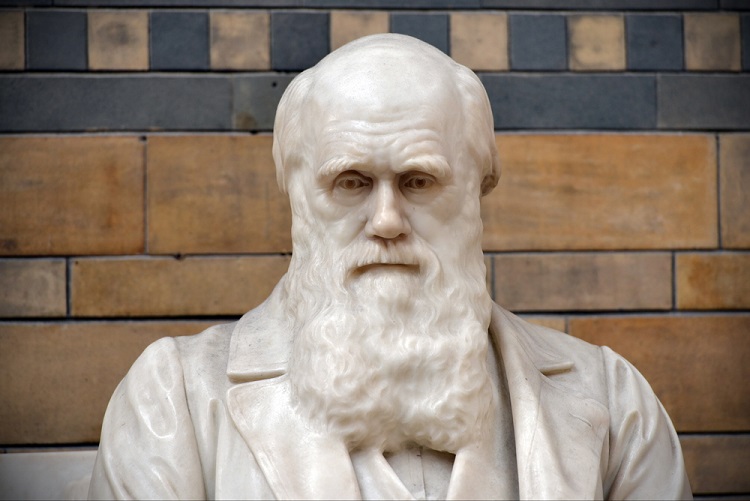
This theory did not sit well with Darwin, who had already made some early observations on how organisms pass down their traits. By 1831, Darwin was given the opportunity of a lifetime. Aboard the H.M.S Beagle, Darwin traveled the globe for nearly 5 years collecting specimens and documenting the vast diversity of life. By 1838, Darwin had a nearly fully formed idea of natural selection.
Darwin’s Theory
In this idea, evolution was driven by four principles. Between individuals, the was variance. Organisms can only get traits via inheritance. A force, natural selection, let’s the fittest animals reproduce the most. Finally, these actions all take place over time, an important aspect of evolution. Together, these principles drive changes over time.
However, Darwin did not publish these ideas immediately. He spent the next 20 years gathering more evidence and solidifying his argument. This process was cut short when Darwin was contacted by Alfred Russel Wallace, a young scientist who had stumbled on the same principles. Together, the two scientists published their theories, confirmed by the fact they had found the theory of natural selection independently.
Quiz
